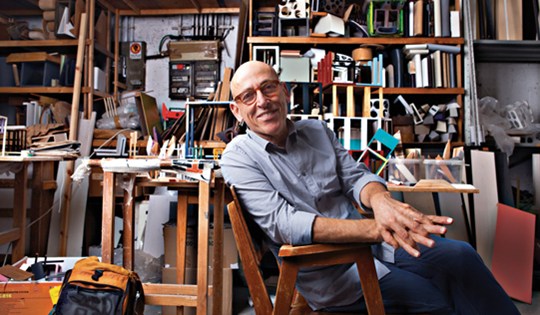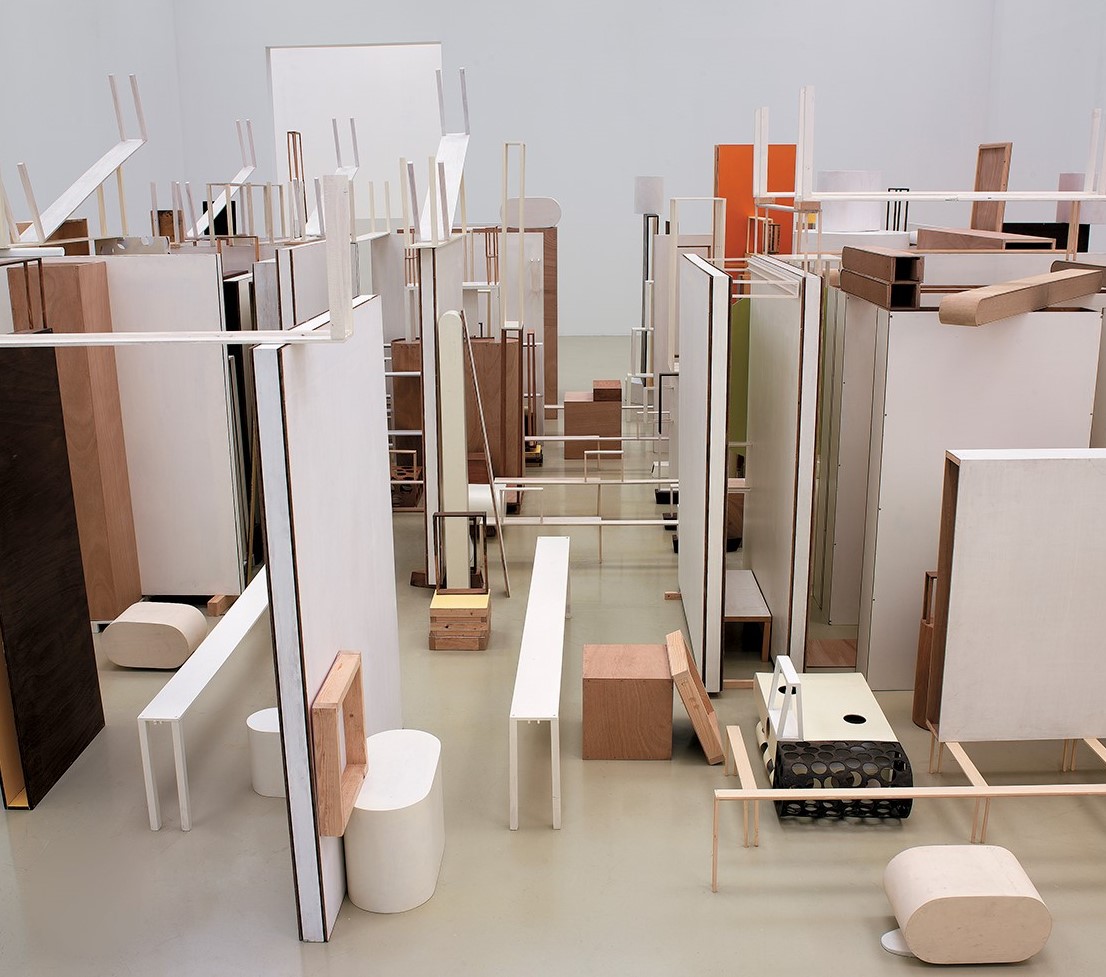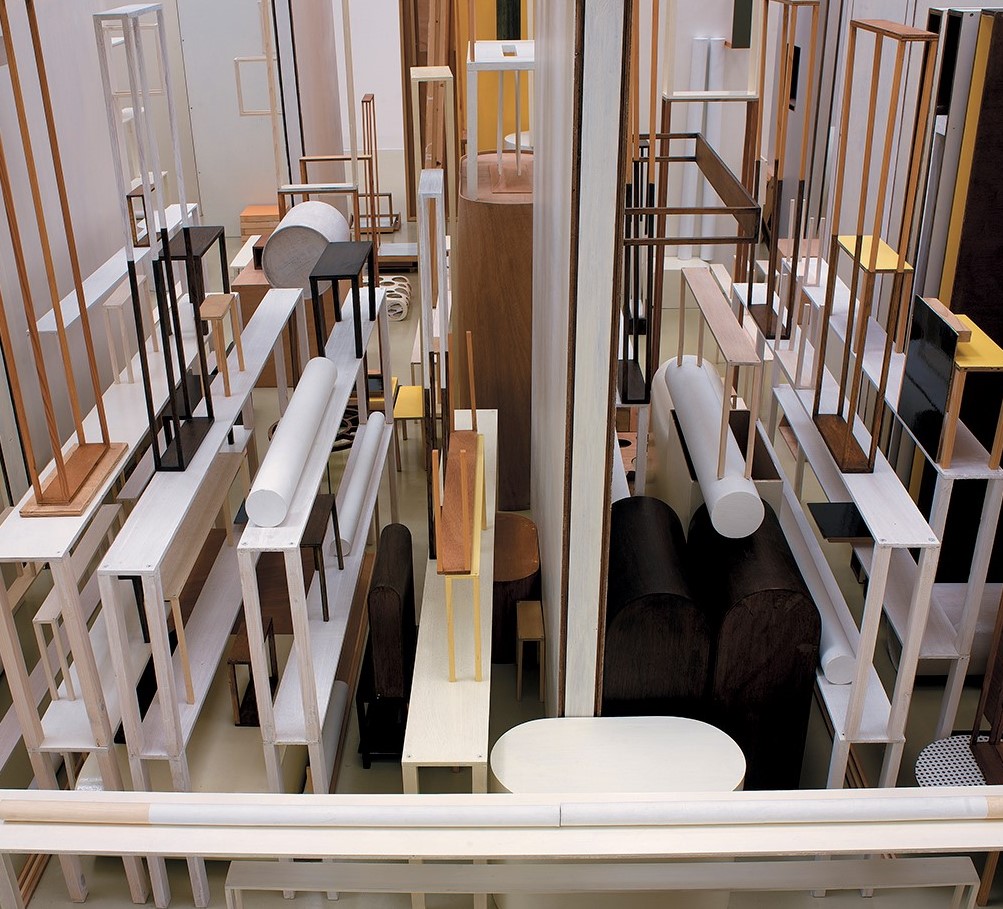Nahum Tevet (born in 1946) lives and works in Tel Aviv. Tevet is a conceptual artist influenced by the traditions of minimalism and Bauhaus. He creates intricate sculptures and installations that are based on shapes from everyday life, and arranged in a complicated structure that looks different from every angle. In his works, Tevet creates a physical experience and examines the relationship between the work of art and the viewer. Tevet served as a professor at the Bezalel Academy of Arts and Design, where he established and managed the master’s program and the continuing education program. For more than 40 years his works have been exhibited in solo exhibitions at prestigious museums and galleries including the House of Art, České Budějovice, Czech Republic (2018); Kristof De Clercq Gallery, Gent, Belgium (2018); Museum Sztuki, Lodz, Poland (2017); Lodz Biennale, Poland (2010); Museum of Contemporary Art of Rome, Italy (2008); The Israel Museum, Jerusalem (2007). In addition, he participated in many group exhibitions, his works are part of important collections and he won multiple prestigious awards.

MIII JAFFA: Hi Nahum, how are you these days?
N.T: All right, having fun in the studio.
MIII JAFFA: Can you tell us something about your work from M III collection we see here?
N.T: I consider this work as a very important one in my artistic biography. While working on it more ideas formed and that led to a large series of installations, a series that was presented entirely at the Israel Museum in 2007 (curator Sarit Shapira RIP).
Up until this work, all of my floor sculptures from the 1980’s began with a central element, from which a strong rotational-spiral motion developed, that “threw and scattered” elements in the space. And here, for the first time, there is no single center, there are many separate occurrences that occur simultaneously, almost competing with each other. This is also my first work that leans on a grid, in a given space, and filling it.
Another novelty in this work, is the density and the intensive use of partition-like elements, walls that delimit. Sections in the work, which I think of as “CUT” like in the cinema, sequences that are cut, erased and hidden. You cannot see the work as a whole or surround it with your gaze. The sections are constructions of objects I have built manually, some of them have sensuality and intimacy that invites you to get closer, almost to touch, and a gap is created between seeing up close to seeing from a far. The scale is also uneven, and it seems to me that there is a sense of rationale that is appealing to read and understand, and a tension between rationality and coincidence, a mix of traditions of modernist abstraction and narrative imagery, like methods that a virus enters them and they go wrong.
Another thing that is innovative in this work, is that there is no screw or glue that holds things together, it is the opposite of previous sculptures that had levitation, that did not consider gravity, here there is a kind of acceptance, almost surrender. Things are just lying on the floor next to each other, on each other, or leaning, a small blow and everything collapses, with all the references to the traditions of modernist sculpture, with the clean whiteness and functionality from the Bauhaus and the kibbutz.
I started this work in 1995, I had a feeling I had exhausted the previous series of sculptures (“Painting Lessons”) and was figuring out how to proceed. I closed the doors of the studio and did not show anyone anything for almost two years, and the work grew slowly, organically, it did not develop from a plan, or from preparation drawings, it was a principle for me, one thing just led to another.
David Neuman came to the studio, with Sarit Shapira RIP, when the work was almost finished, and after a week he called and ordered the work to an exhibition called “Painting: the extended field” an exhibition with a list of “Hollywood” participants, Paul McCarthy, Luc Tuymans, Jessica Stockholder, Imi Knoebel and others, a great exhibition. He purchased the work for the collection from the exhibition.
MIII JAFFA: In the context of these days, do you experience it differently?
N.T: Since the 1980s, my work has had a kind of defiance to photography, to the image of a single snapshot “showing” a statue. Even then, and certainly in the 1990s, I was busy creating a physical experience, physical-sensory, almost tactile experience as a course of reading the work, and the time it took to experience my works was important to me. Today I see this resistance is even more relevant, as we see art and experience everything through screens.
MIII JAFFA: What are you working on now?
N.T: I started a series of works, slightly different from previous works. I used to have a series of sculptures called “Painting Lessons” that considered the relationship between painting and sculpture. My Recent works return to this consideration.
I start with combinations of painted plywood surfaces on the floor, representations of painting formulas that have gotten off the wall. These paintings serve as a stage on which I place objects, for example a bench, chair, boat, etc. Later on, it all climbs from the floor to the wall. Then the objects “stand” on the wall and create a situation as if the floor has folded into the wall. This process has appeared in different ways in previous works as well, but here it’s right at the heart of the matter, I love such adventures, when it’s not clear where it all leads.
MIII JAFFA: Thoughts about the future?
N.T: I am surprised at how many more directions you can take my ongoing project, I have a lot of ideas and I get into things that are new to me and work with enthusiasm and joy. In this sense, canceled exhibitions abroad give me some time to breath, and awaken thoughts on working in a studio when the “system” is paralyzed. This is actually the purest time to “make art”.







